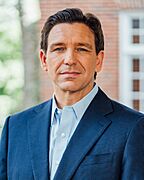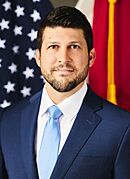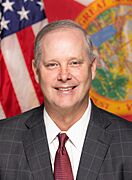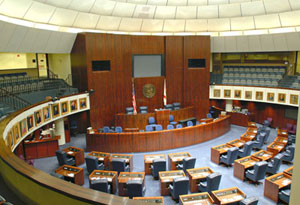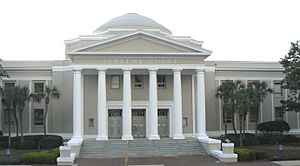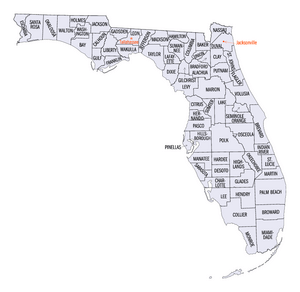Government of Florida facts for kids
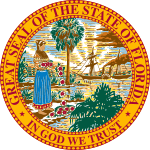
|
|
| Polity type | Sub-national administrative division (federated state) |
|---|---|
| Part of | United States of America |
| Constitution | Constitution of Florida |
| Legislative branch | |
| Name | Legislature |
| Type | Bicameral |
| Meeting place | Florida Capitol |
| Upper house | |
| Name | Senate |
| Presiding officer | Ben Albritton, President |
| Lower house | |
| Name | House of Representatives |
| Presiding officer | Daniel Perez, Speaker |
| Executive branch | |
| Head of State and Government | |
| Title | Governor |
| Currently | Ron DeSantis |
| Appointer | Election |
| Cabinet | |
| Name | Cabinet |
| Leader | Governor |
| Deputy leader | Lieutenant Governor |
| Headquarters | State Capitol |
| Judicial branch | |
| Name | Judiciary of Florida |
| Chief Justice | Carlos G. Muñiz |
| Courts | Courts of Florida |
| Supreme Court of Florida | |
| Chief judge | Carlos G. Muñiz |
| Seat | Tallahassee |
The government of Florida is how the state is run. It follows the rules set in the Constitution of Florida. This government has three main parts, called "branches," which work together to make sure power is shared. These branches are the executive, legislative, and judicial. Florida also lets its citizens vote directly on certain laws and changes.
Contents
Executive Branch: Leading the State
The executive branch of Florida's government is like the state's management team. It includes the Governor, the Lieutenant Governor, and the Florida Cabinet. The Cabinet has important members like the Attorney General, the Commissioner of Agriculture, and the Chief Financial Officer. Each of these elected officials can serve up to two four-year terms.
- Elected executive officials in Florida
-
Ron DeSantis (R)
Governor
The Governor: Florida's Top Leader
The Governor of Florida is the state's chief executive. This means they are in charge of making sure Florida's laws are carried out. The Governor also plans the state's budget and leads the state's military forces when they are not working for the United States. Each year, the Governor gives a "State of the State Address" to the Florida Legislature. In this speech, they talk about how the state is doing and suggest new laws.
The Cabinet: A Team of Leaders
Florida has a special system with a strong Cabinet. Unlike many other states, the members of Florida's Cabinet are elected separately. They work with the Governor on important decisions. The Cabinet includes the Attorney General, the Commissioner of Agriculture, and the Chief Financial Officer. Each member, including the Governor, gets one vote on decisions. If there's a tie, the Governor's vote breaks it. Cabinet elections happen every four years.
Attorney General: The State's Lawyer
The Florida Attorney General is the state's main legal officer. They can appoint a special prosecutor to handle crimes that happen across different parts of Florida. The Attorney General also leads the Florida Department of Legal Affairs.
Chief Financial Officer: Managing Money
The Chief Financial Officer of Florida watches over the state's money. Their job is to make sure state programs spend money correctly. They also oversee how the state collects and uses its funds. This officer leads the Florida Department of Financial Services.
Commissioner of Agriculture: Protecting Food and Consumers
The Florida Commissioner of Agriculture leads the Florida Department of Agriculture and Consumer Services. This department helps farmers and protects consumers.
State Agencies: Making Rules Work
State agencies create rules to help carry out the laws passed by the legislature. These rules help manage different areas, like financial services and health. In 2010, the state had about 122,000 employees working in these agencies.
Legislative Branch: Making Laws
Florida's law-making branch is called the Florida Legislature. It has two parts: the Florida Senate and the Florida House of Representatives. Both groups meet in the Florida State Capitol building.
Senate and House Members
The Florida Senate has 40 members. They serve four-year terms, with half of them up for election every two years. The Florida House of Representatives has 120 members. They serve two-year terms. Members of both houses can serve a maximum of eight years.
Legislative Sessions: When Laws Are Made
The Legislature meets for a regular session each year. This session lasts for 60 days. It usually starts in March with the Governor's speech. The Legislature also holds special sessions for specific reasons, like reducing the budget. These special sessions can be called by the Governor or by a vote of the members.
Judicial Branch: Interpreting Laws
The Florida State Courts System is the part of government that interprets laws. It makes sure laws are applied fairly. This system includes different levels of courts.
Florida's Court System
- Florida Supreme Court: This is the highest court in Florida. It has seven judges and is the final decision-maker on Florida law. Its decisions must be followed by all other state courts.
- District Courts of Appeal: There are five of these courts. They handle appeals, meaning they review decisions made by lower courts.
- Trial Courts: These are where cases start. Florida has 20 circuit courts and 67 county courts.
* Circuit Courts: These courts handle serious civil cases (money disputes over $15,000) and major criminal cases (felonies). They also hear appeals from county courts. * County Courts: These courts handle less serious criminal cases (misdemeanors) and smaller civil cases (money disputes up to $15,000).
State Budget: How Florida Spends Money
Every part of the government, from the state to counties and cities, has its own budget. This budget shows how much money they expect to receive and how they plan to spend it.
Capital City: Tallahassee
Tallahassee was chosen as Florida's capital city in 1823. It was picked because it was located between Florida's two largest cities at the time, Pensacola and Saint Augustine. Over the years, there were ideas to move the capital. This was because Tallahassee became far from many people as Florida's population grew south. However, these ideas stopped after the new Florida Capitol building opened in Tallahassee in 1977.
Local Government: Closer to Home
Florida has four main types of local governments: counties, municipalities (cities, towns, villages), school districts, and special districts.
Counties: Local Divisions
Florida has 67 counties. Each county has elected officials like the sheriff and tax collector. These officials are paid locally, but they can only be removed from office by the Governor.
School Districts: Education in Each County
Each county has its own school district. Voters in a county can decide if their school superintendent is elected or appointed.
Municipalities: Cities and Towns
Municipalities are cities, towns, or villages. They provide services like police, fire departments, water, and trash collection. They can pass their own laws, called ordinances, and collect taxes. If there's a conflict between a county law and a city law, the city law usually wins within the city's borders.
Special Districts: Specific Services
Special districts are created for specific purposes. For example, "community development districts" can have many powers similar to a city or county, except for police power. Famous examples include the Reedy Creek Improvement District (where Walt Disney World is located) and much of The Villages retirement community.
Images for kids
See also
 In Spanish: Gobierno de Florida para niños
In Spanish: Gobierno de Florida para niños
- Administrative divisions of Florida
- List of counties in Florida
- Elections in Florida
- Politics of Florida
- Law of Florida


